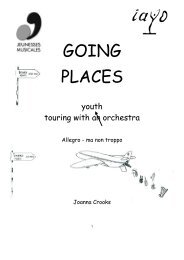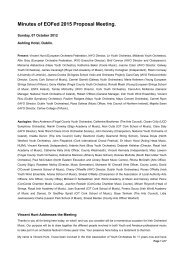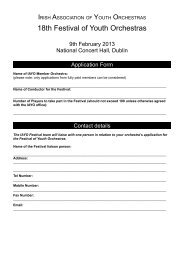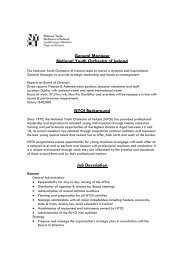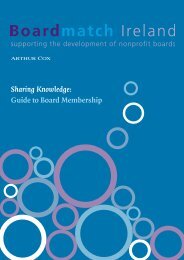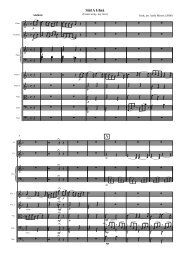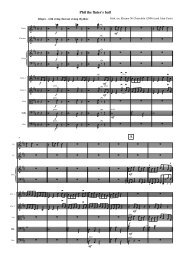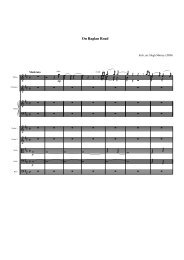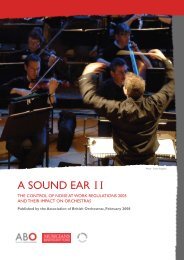download the score of In C - Flagmusic
download the score of In C - Flagmusic
download the score of In C - Flagmusic
Create successful ePaper yourself
Turn your PDF publications into a flip-book with our unique Google optimized e-Paper software.
in C.<br />
1. 2. 3. 4. 5. 6.<br />
<br />
<br />
<br />
<br />
<br />
<br />
<br />
<br />
<br />
<br />
<br />
<br />
7. 8. 9. 10.<br />
<br />
<br />
<br />
<br />
<br />
<br />
<br />
<br />
<br />
<br />
<br />
̇ ̇ <br />
♯<br />
̇ <br />
<br />
<br />
<br />
<br />
<br />
♯ ̇ <br />
̇<br />
̇<br />
<br />
♯ <br />
̇<br />
♯ ̇ <br />
<br />
̇ ̇ ̇ ̇ ̇ ♯̇<br />
̇ ̇ <br />
♯̇<br />
̇ ̇ ̇ ̇ ̇ ̇ <br />
♯ ̇ ̇ ̇ ̇ ̇ ̇ <br />
<br />
<br />
♯<br />
̇ ̇ ̇ ̇ ̇ ̇<br />
♯<br />
̇ ̇ ̇ ̇ ̇<br />
♯<br />
♯ ̇<br />
<br />
33. 34.<br />
<br />
̇<br />
̇<br />
̇<br />
̇<br />
<br />
<br />
̇<br />
̇ <br />
<br />
<br />
♮ <br />
<br />
̇ ̇<br />
<br />
<br />
♭<br />
̇ ♯<br />
̇<br />
♮ ̇<br />
<br />
<br />
(<br />
( ̇ <br />
̇ <br />
<br />
(<br />
(<br />
11. 12. 13. 14. 15.<br />
16. 17. 18. 19. 20. 21.<br />
22. 23. 24.<br />
25. 26. 27. 28.<br />
29. 30. 31. 32.<br />
35.<br />
36. 37. 38. 39. 40. 41. 42.<br />
<br />
<br />
<br />
<br />
<br />
<br />
<br />
<br />
43. 44. 45. 46. 47.<br />
<br />
<br />
<br />
<br />
<br />
<br />
<br />
<br />
<br />
<br />
<br />
<br />
<br />
<br />
(<br />
48. 49. 50. 51. 52. 53.<br />
<br />
̇ ( ♭ ♭<br />
♭<br />
<br />
♭ © P 1989<br />
<br />
<br />
(<br />
<br />
(<br />
(<br />
(<br />
(<br />
(<br />
© 1964<br />
Terry Riley<br />
Celestial Harmonies
<strong>In</strong> C<br />
Performing Directions<br />
All performers play from <strong>the</strong> same page <strong>of</strong> 53 melodic patterns played in sequence.<br />
Any number <strong>of</strong> any kind <strong>of</strong> instruments can play. A group <strong>of</strong> about 35 is desired if<br />
possible but smaller or larger groups will work. If vocalist(s) join in <strong>the</strong>y can use any<br />
vowel and consonant sounds <strong>the</strong>y like.<br />
Patterns are to be played consecutively with each performer having <strong>the</strong> freedom to<br />
determine how many times he or she will repeat each pattern before moving on to<br />
<strong>the</strong> next. There is no fixed rule as to <strong>the</strong> number <strong>of</strong> repetitions a pattern may have,<br />
however, since performances normally average between 45 minutes and an hour and<br />
a half, it can be assumed that one would repeat each pattern from somewhere<br />
between 45 seconds and a minute and a half or longer.<br />
It is very important that performers listen very carefully to one ano<strong>the</strong>r and this<br />
means occasionally to drop out and listen. As an ensemble, it is very desirable to<br />
play very s<strong>of</strong>tly as well as very loudly and to try to diminuendo and crescendo<br />
toge<strong>the</strong>r.<br />
Each pattern can be played in unison or canonically in any alignment with itself or<br />
with its neighboring patterns. One <strong>of</strong> <strong>the</strong> joys <strong>of</strong> IN C is <strong>the</strong> interaction <strong>of</strong> <strong>the</strong><br />
players in polyrhythmic combinations that spontaneously arise between patterns.<br />
Some quite fantastic shapes will arise and disintegrate as <strong>the</strong> group moves through<br />
<strong>the</strong> piece when it is properly played.<br />
It is important not to hurry from pattern to pattern but to stay on a pattern long<br />
enough to interlock with o<strong>the</strong>r patterns being played. As <strong>the</strong> performance<br />
progresses, performers should stay within 2 or 3 patterns <strong>of</strong> each o<strong>the</strong>r. It is<br />
important not to race too far ahead or to lag too far behind.<br />
The ensemble can be aided by <strong>the</strong> means <strong>of</strong> an eighth note pulse played on <strong>the</strong> high<br />
c’s <strong>of</strong> <strong>the</strong> piano or on a mallet instrument. It is also possible to use improvised<br />
percussion in strict rhythm (drum set, cymbals, bells, etc.), if it is carefully done and<br />
doesn’t overpower <strong>the</strong> ensemble. All performers must play strictly in rhythm and it<br />
is essential that everyone play each pattern carefully. It is advised to rehearse<br />
patterns in unison before attempting to play <strong>the</strong> piece, to determine that everyone is<br />
playing correctly.
page 2<br />
The tempo is left to <strong>the</strong> discretion <strong>of</strong> <strong>the</strong> performers, obviously not too slow, but<br />
not faster than performers can comfortably play.<br />
It is important to think <strong>of</strong> patterns periodically so that when you are resting you are<br />
conscious <strong>of</strong> <strong>the</strong> larger periodic composite accents that are sounding, and when you<br />
re-enter you are aware <strong>of</strong> what effect your entrance will have on <strong>the</strong> music’s flow.<br />
The group should aim to merge into a unison at least once or twice during <strong>the</strong><br />
performance. At <strong>the</strong> same time, if <strong>the</strong> players seem to be consistently too much in<br />
<strong>the</strong> same alignment <strong>of</strong> a pattern, <strong>the</strong>y should try shifting <strong>the</strong>ir alignment by an<br />
eighth note or quarter note with what’s going on in <strong>the</strong> rest <strong>of</strong> <strong>the</strong> ensemble.<br />
It is OK to transpose patterns by an octave, especially to transpose up. Transposing<br />
down by octaves works best on <strong>the</strong> patterns containing notes <strong>of</strong> long durations.<br />
Augmentation <strong>of</strong> rhythmic values can also be effective.<br />
If for some reason a pattern can’t be played, <strong>the</strong> performer should omit it and go<br />
on.<br />
<strong>In</strong>struments can be amplified if desired. Electronic keyboards are welcome also.<br />
IN C is ended in this way: when each performer arrives at figure #53, he or she<br />
stays on it until <strong>the</strong> entire ensemble has arrived <strong>the</strong>re. The group <strong>the</strong>n makes a large<br />
crescendo and diminuendo a few times and each player drops out as he or she<br />
wishes.



